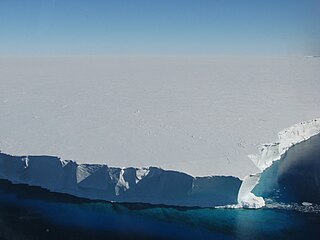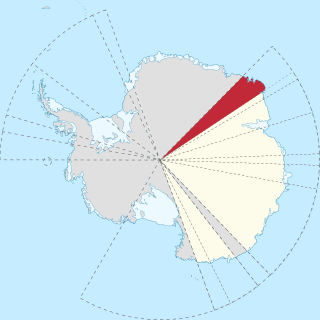Related Research Articles


The Prince Charles Mountains are a major group of mountains in Mac. Robertson Land in Antarctica, including the Athos Range, the Porthos Range, and the Aramis Range. The highest peak is Mount Menzies, with a height of 3,228 m (10,591 ft). Other prominent peaks are Mount Izabelle and Mount Stinear. These mountains, together with other scattered peaks, form an arc about 420 km (260 mi) long, extending from the vicinity of Mount Starlight in the north to Goodspeed Nunataks in the south.
Cape Darnley is the ice-covered cape forming the northern extremity of Bjerkø Peninsula at the west side of MacKenzie Bay. On December 26, 1929, Sir Douglas Mawson, from the masthead of the RRS Discovery while at 66°57′S71°57′E, saw land miraged up on the southwest horizon. On February 10, 1931, he returned in the Discovery and was able to approach close enough to see the headland, naming it for E.R. Darnley, Chairman of the Discovery Committee of the Colonial Office, London, 1923 to 1933.

Mertz Glacier is a heavily crevassed glacier in George V Coast of East Antarctica. It is the source of a glacial prominence that historically has extended northward into the Southern Ocean, the Mertz Glacial Tongue. It is named in honor of the Swiss explorer Xavier Mertz.
The Mawson Coast is that portion of the coast of Mac. Robertson Land, Antarctica, lying between William Scoresby Bay, at 59°34′E, and Murray Monolith, at 66°54′E. The coast was sighted during the British Australian New Zealand Antarctic Research Expedition (BANZARE), 1929–30, under Sir Douglas Mawson. Further exploration and landings at Cape Bruce and Scullin Monolith were made during BANZARE, 1930–31. Mawson Coast was named by the Antarctic Names Committee of Australia after Mawson in recognition of his great contribution to Antarctic exploration.
The Scott Mountains are a large number of isolated peaks lying south of Amundsen Bay in Enderby Land of East Antarctica, Antarctica. Discovered on 13 January 1930 by the British Australian New Zealand Antarctic Research Expedition (BANZARE) under Sir Douglas Mawson. He named the feature Scott Range after Captain Robert Falcon Scott, Royal Navy. The term mountains is considered more appropriate because of the isolation of its individual features.

Enderby Land is a projecting landmass of Antarctica. Its shore extends from Shinnan Glacier at about 67°55′S44°38′E to William Scoresby Bay at 67°24′S59°34′E, approximately 1⁄24 of the earth's longitude. It was first documented in western and eastern literature in February 1831 by John Biscoe aboard the whaling brig Tula, and named after the Enderby Brothers of London, the ship's owners who encouraged their captains to combine exploration with sealing.
Athos Range is the northernmost range in the Prince Charles Mountains of Mac. Robertson Land, Antarctica. The range consists of many individual mountains and nunataks that trend east–west for 40 miles (64 km) along the north side of Scylla Glacier.
Ufs Island is a rocky island 3.2 km (2 mi) wide, lying in the east part of Howard Bay, Antarctica, just north of the Lachal Bluffs, and about 4 km (2.5 mi) west of Allison Bay. Cape Simpson, the north end of this island, was discovered by the British Australian New Zealand Antarctic Research Expedition (BANZARE) under Mawson in February 1931, but the feature's insularity was first recognized by Norwegian cartographers working from aerial photographs taken by the Lars Christensen Expedition, 1936–37. They named it Ufsoy.
Howard Bay is a 2-mile (3 km) wide body of water in Antarctica, lying between Byrd Head to the west and Ufs Island and the Lachal Bluffs to the east. It was discovered in February 1931 by the British Australian New Zealand Antarctic Research Expedition under Douglas Mawson, and was named by him after A. Howard, the expedition's hydrologist.
Utstikkar Glacier is a broad glacier flowing north from the vicinity of Moyes Peak in Antarctica and terminating in Utstikkar Glacier Tongue between Utstikkar Bay to the east and Allison Bay to the west. The glacier was mapped and named Utstikkarbreen by Norwegian cartographers working from aerial photographs taken by the Lars Christensen Expedition in January–February 1937.
Assender Glacier is a glacier flowing west into Spooner Bay in Enderby Land, Antarctica. It was plotted from air photos taken from Australian National Antarctic Research Expeditions aircraft in 1956, and named by the Antarctic Names Committee of Australia for Pilot Officer Ken J. Assender, RAAF, pilot at Mawson Station in 1959.
Kirkby Head is a sheer coastal outcrop on Tange Promontory in Enderby Land, Antarctica, which is claimed by Australia as part of the Australian Antarctic Territory. Continental ice reaches almost to the top on its southern side. It is located at the east side of the entrance to Alasheyev Bight.
Wilma Glacier is the western of two glaciers entering the southern part of Edward VIII Ice Shelf in Kemp Land, East Antarctica. The second, eastern glacier is Robert Glacier.
On the continent of Antarctica, the Aramis Range is the third range south in the Prince Charles Mountains, situated 11 miles southeast of the Porthos Range and extending for about 30 miles in a southwest–northeast direction. It was first visited in January 1957 by Australian National Antarctic Research Expeditions (ANARE) southern party led by W.G. Bewsher, who named it for a character in Alexandre Dumas' novel The Three Musketeers, the most popular book read on the southern journey.
Byrd Head is a conspicuous, rocky headland on the Mawson Coast 1 mi southeast of Colbeck Archipelago, just west of Howard Bay. Discovered in February 1931 by the British Australian and New Zealand Antarctic Research Expedition (BANZARE) under Douglas Mawson, who named it for R. Admiral Richard E. Byrd, U.S. Navy (USN).
Falla Bluff is a prominent rocky coastal bluff at the head of Utstikkar Bay. It was discovered in February 1931 by the British Australian New Zealand Antarctic Research Expedition under Mawson, and named by him for R.A. Falla, ornithologist with the expedition.
The Stanton Group is a group of small rocky islands close to the coast at the east side of Utstikkar Bay, 4 nautical miles (7 km) northeast of Falla Bluff discovered in February 1931 by the British Australian New Zealand Antarctic Research Expedition (BANZARE) under Mawson. He named it for A. M. Stanton, first officer of the Discovery, 1930–31.
The Lachal Bluffs are a group of rocky headlands located just south of Ufs Island and east of Howard Bay, and about 4 kilometres (2.5 mi) west of Allison Bay, on the Mawson Coast of Mac. Robertson Land, Antarctica. They were mapped by Norwegian cartographers from air photos taken by the Lars Christensen Expedition, 1936–37, and named by the Antarctic Names Committee of Australia for R. Lachal, an assistant cook at Mawson Station, who acted as a geological field assistant, 1965.
References
 This article incorporates public domain material from "Allison Bay". Geographic Names Information System . United States Geological Survey.
This article incorporates public domain material from "Allison Bay". Geographic Names Information System . United States Geological Survey.